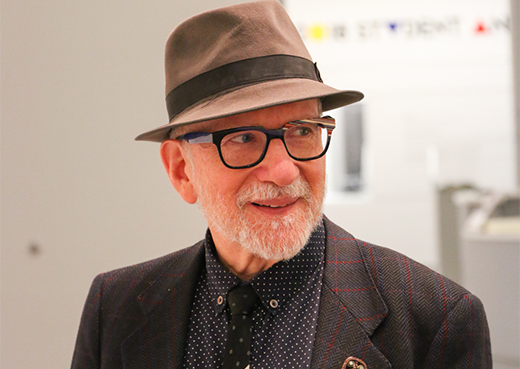
Barry Blinderman retires July 1 after 31 years as director of University Galleries at Illinois State University where he helped narrow the divide between coastal and inland art. (Photo by Monica Mendoza, Illinois State University)

PAUL KRAINAK
While my column is generally about art in the Midwest, this month’s notes on Barry Blinderman’s retirement from Illinois State University speak to a germane link between coastal and inland art. In the 1980s, Barry was the director and co-owner of Semaphore Gallery, a West Broadway destination in New York City during the ascendancy of graffiti art, neo-expressionism, neo-pop, et al. I first met him in 1982 when he came to Chicago to work the Art Fair at Navy Pier. He dropped in at N.A.M.E., an alternative space where I was director, and we discussed an exchange between the two spaces. We planned a project that included members Michiko Itatani, Guy Whitney, Othello Anderson plus a few friends of the space like Dennis Kowalski, Buzz Spector and Mary Ahrendt. I was enthused. SoHo and the East Village, where Barry opened a second venue, had entered a phase of virtual post-bohemianism –– one part unapologetically market-driven and the other feverishly experimental and political.
Meeting Barry was instrumental in my decision to move to New York a year later. I wrote an art column for a new paper named SoHo Arts Weekly. My editor was focused on poetry and the performing arts but liked putting visual art on the cover to draw readers. The ‘80s in New York were open for business and a new generation of artists and dealers sought the attention of even fledgling press, if it meant a glimpse of themselves on the newsstand.
Barry took risks with emerging artists, including Martin Wong, Walter Robinson, Robert Colescott, Duncan Hannah, Nancy Dwyer, Jane Dickson, Lady Pink. His first location was small and on the second floor, but smart and in the moment. He was the most congenial of dealers. As an art historian, he was credible about aesthetics and theory, affording him numerous vantage points to connect with patrons, artists and critics. His confidence and humor were contagious and disarming, and he invited everyone to the party. Once his very charming mother called the gallery. Semaphore was busy with artists and guests as she began an extended parental narrative on Barry’s business profile and his life in general. I recall it clearly because Barry placed her on speakerphone, and we all were in tears.
After seven years in New York Barry re-entered academia, this time as Director of University Galleries at ISU, where he also contributed to the art history and graduate studio program. This was a smart call for Barry and for the University as there’s no better policy then hiring faculty with real world experience who can cook. It paid dividends for Barry and the school. He contributed to both regional and national art, mentored scores of students and staff, and published numerous scholarly and insightful books on contemporary artists and developments.
Consider a few comments that the new Curator of Exhibitions and Collections at the Peoria Riverfront Museum Bill Conger, gave at Barry’s retirement celebration. “Barry’s arrival in Normal, Illinois, completely transformed the direction of University Galleries and Illinois State University’s art department by bringing ‘80s powerhouse, contemporary artists such as Kiki Smith, Walter Robinson, Robert Longo, Wonsook Kim, Duncan Hannah, Michael Smith, Kenny Scharf and writers like Dave Hickey, Irving Sandler, and Timothy Leary. He brought the elucidating and traumatic work of David Wojnarowicz to University Galleries during the AIDS crisis and weathered the vitriol of the Religious Right, Reverend Donald Wildmon on a national stage.”
Barry did everything on a modest budget that he augmented through grant writing, book sales, and travelling noteworthy exhibitions such as Walter Robinson, Michelle Grabner, Jane Dickson and Tony Tasset. In his last few years at ISU he played a part in extending the school’s footprint into Normal’s cultural and business center by helping to oversee the design and construction of a stunning, state-of-the-art 7,500-square-foot exhibition space.
Barry’s exuberance and eye for contemporary art remains, and it should give us pause that he’ll no longer be at the helm of the University Galleries. He’s a son of the eighties, one of the artworld’s most mythologized periods, and a benefactor of three decades of cultural decentralization enabled by universities like ISU. Thirty-one years as the director of any program is a feat, and I won’t forget his challenging work and our friendship. Barry was and still is a fiercely independent thinker, writer, musician, and as of July 1, a free agent.

3 comments for “Inland Art | Barry Blinderman”